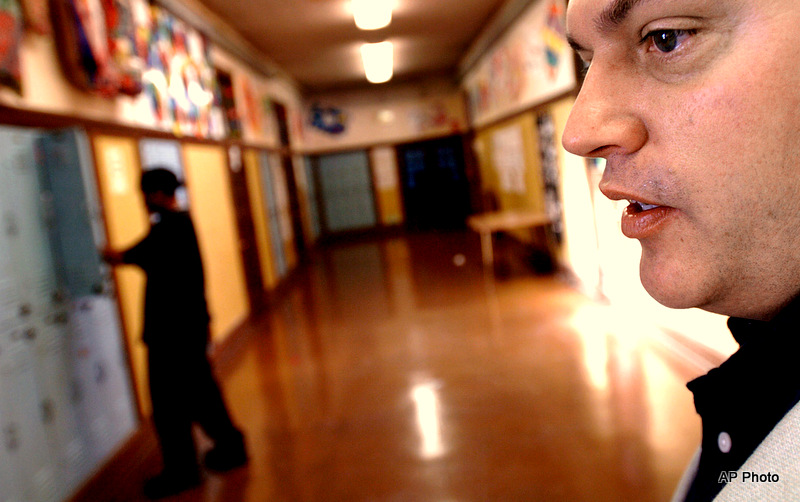
SACRAMENTO, California — Both inside and outside the classroom, more and more U.S. students’ lives are increasingly digital and Internet-based. Tapping into public school students’ smartphones and tracking their whereabouts is a booming business for some companies looking to grow their bottom lines.
Yet this data gathering is happening through the use of government funds and without much debate among the general public. MintPress News investigates some of the companies, policies, and politics swirling around in the tax dollar, public schools, and technology nexus.
Education entrepreneurs
Texas is a leading state in this new education business trend. Dallas-based AIM Truancy Solutions uses mobile phones to “mentor” — not monitor — 4,000 truant Texas public school students, Brian Dooley, AIM’s operations director, explained to MintPress News.
AIM never uses GPS ankle bracelets on truant students, he said via email, noting that the company’s founders did have court experience with such devices and found “them to be of limited effectiveness.” The growth of cellphone usage, “even within impoverished communities,” has made those devices the hardware of choice for AIM’s truancy prevention business, Dooley stated.
According to Dooley, the company “strictly follows Family Educational Rights and Privacy Act guidelines which require written consent for schools to share information. AIM only shares individual statistics and reports back to the schools and districts that provided the original data.”
Meanwhile, California has also seen growth in truancy-related policy and businesses. School Innovations & Achievement (SI&A) is a private firm based in El Dorado Hills, about 22 miles east of Sacramento. The company’s Attention 2 Attendance (A2A) software program covers 1,400 schools and 1 million pupils, according to its website. A2A is the most popular student attendance software program in the Golden State, a spokesperson for the California Department of Education told MintPress in an email.
“SI&A serves an estimated 75 percent of California’s students with one or more products annually,” according to the Association of California School Administrators, which counts SI&A among its corporate partners.
SI&A relies on a steady stream of public tax dollars, but SI&A staff declined to answer a query from MintPress regarding contracts with local public school districts and student data privacy safeguards.
Like AIM in Dallas, Omnilink Systems Inc. uses cellphones to track truant students, but it started its education entrepreneurship by fitting youth with blatantly criminalizing ankle monitors. According to the company’s website, “Today, Omnilink is the technology of choice for more than 750 agencies and service providers throughout the criminal justice system and is one of the fastest-growing electronic monitoring companies in the world.” A spokeswoman for the Numerex Corp, which recently acquired Omnilink for $37.5 million, declined to share with MintPress the names of agencies and customers using its truancy tracking software.
Laws and order?
SI&A is listed as a contributor in California Attorney General Kamala D. Harris’ 2013 report on absenteeism and truancy, an annual report titled “In School + On Track,” so is it a coincidence that the state Legislature passed four school attendance and truancy bills that Harris supported?
A.B. 1584 — a bill that Harris did not support, but Gov. Jerry Brown signed late last month — focuses on student privacy. The bill, as summarized by Assemblymember Joan Buchanan, “ensures that student records remain private regardless of whether they are stored in a file cabinet or the cloud and that parents will retain the right to view and correct any inaccuracies.” Harris’ press contact for the office declined to reply to MintPress’ questions about student data privacy.
In the Golden State, if a child misses too much school, he or she can be forced to wear a GPS tracking device to ensure attendance compliance. In a recent California Court of Appeals case, it was ruled, 3-0, that chronically truant minors can be ordered to wear a GPS monitoring device as a condition of probation pursuant to California Welfare and Institutions Code section 601. This section states that a California minor only has to skip four days of school to become a ward of the court.
This decision came about after Gabriela M., a habitually truant 14-year-old Oakland, California, student, was declared a ward of the court and placed on home probation on Feb. 27, 2012. She was ordered to attend school daily, and abide by other court demands that she “abide by household rules.” By Feb. 1, 2013, after missing many more classes and exhibiting other behavioral problems, including leaving her home without permission and drinking alcohol, the juvenile court placed the chronically truant student on GPS monitoring, held her in juvenile hall for two weekends, and ordered her to remain on GPS monitoring upon her release. One week later, she filed her appeal of the court’s decision.
The student complied with her GPS contract terms, and maintained her previously-filed legal challenge that argues GPS monitoring is not a valid condition of probation for truancy. The First District Court of Appeal in San Francisco affirmed the GPS tracking of truant students, representing an important legal decision for families concerned about student privacy matters.
School-to-prison pipeline

Attorney Deborah Fowler helms the legal branch of Texas Appleseed, a social justice nonprofit. She says that in the early 1990s, Lone Star State lawmakers made youth truancy a Class C misdemeanor for adjudication in adult courts, funded by adult and juvenile offender fines. A misdemeanor record negatively impacts truant youth in their adult life prospects (i.e., jobs and shelter), she told MintPress by phone, explaining that the policies of “exclusionary discipline and law enforcement referrals” over-criminalize young people, pushing them into what Fowler and others term the “school-to-prison pipeline.”
Professor Hadar Aviram, Harry and Lillian Hastings Research Chair at the University of California Hastings College of the Law, concurs with Fowler’s assessment.
“One concern with focusing on truancy is that, while it might be a preventative measure, it also points fingers and criminalizes people at a fairly early stage of their lives,” Aviram, author of “Cheap on Crime,” told MintPress via email. “It also raises ethical questions of parental responsibility, such as with ‘truancy courts’ that charge the parents with their children’s absenteeism.”
Flow of school funding
Absenteeism can cost school districts, so ethical questions take a back seat to fiscal imperatives. In states such as California and Texas, local school districts receive a per-pupil amount of tax dollars based on students’ daily presence in classrooms. This policy, known as Average Daily Attendance, is “calculated by dividing the total days of student attendance by the total days of instruction. ADA is then multiplied by a certain dollar amount, which varies by grade, to determine the amount of funding a district or county will receive for the year,” according to California Attorney General Harris’ 2014 “In School + On Track” report on elementary school absenteeism and truancy.
School districts contract with private firms to follow that education process and achieve that funding goal. Naturally, some see the benefits of the latest digital education tools in the classroom, and an aversion to technology can almost be read as an aversion to teaching itself. In fact, it now is technological catch-up time in classrooms across the U.S., according to Jeff Kagan, a tech industry consultant.
“Generally speaking, the current state of technology in our education system is behind the curve,” Kagan told MintPress via email. “However, there are a few companies and technologies which can help education in a variety of ways, including truancy.”
Profits over privacy?
Given the persistence of cash-strapped school districts, the growth in data harvesting facilitated by new technologies, like smartphones, and a lack of a commitment to protecting student privacy among public officials, there’s a clear profit incentive blatantly facilitated by public policy. In a phone interview with MintPress, Lee Tien of the Electronic Frontier Foundation, a digital rights advocacy group, cited “the general lack of a student privacy infrastructure” as one of the greatest concerns in this brave new world.
Tien blamed “woefully out of date” federal regulations and a lack of school employee technology training — or “no institutional competence” — as two main culprits aiding the rise of unregulated data mining and student monitoring companies.
Another major issue is that student information is economically valuable, Tien said. “There’s a reason why folks are trying to make deals in schools… because they are thinking about monetizing the data… That’s a demand for data.”
Average Daily Attendance is a “serious bottom line,” according to Tien.
In this emerging market, the public may catch on to the growing monetization of student data. Class Size Matters, an education policy organization, has challenged inBloom Corporation’s attempts to collect and monetize student data stored in an Amazon.com cloud. inBloom folded its operations, which included servicing vendors in nine states, but given the lucrative nature of student data, this market isn’t likely to wither without a fight.
Further, the key role truancy plays in the school-to-prison pipeline risks development of a two-tiered system of student privacy rights. It’s possible that in such a system one tier could be more carefully regulated while truants are monitored by unregulated courts using new technologies.
Michelle Renee Matisons, Ph.D., can be reached at [email protected]
Seth Sandronsky is a Sacramento-based journalist and member of the freelancers unit of the Pacific Media Workers Guild. Email [email protected]

